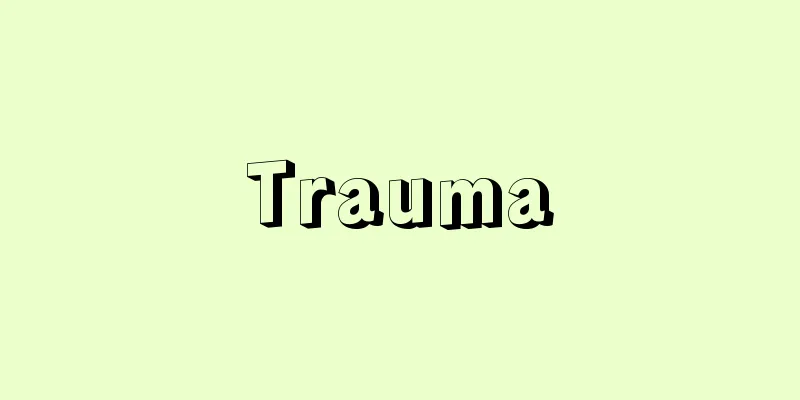Trauma

|
It refers to an injury caused to a part of the body by an external force, commonly referred to as "injury." There is a word "wound" to describe the state of the injury, with "wound" generally used to refer to an open wound in the skin or mucous membranes that cover the outer surface of the body, and "wound" to refer to a closed wound in which the tissues below the skin have been damaged. In addition, a broken bone is called a fracture, an injury to the ligaments or soft tissues that make up a joint is called a sprain, and a bone coming out of a joint is called a dislocation. In addition, external forces can be mechanical forces caused by hard, tangible objects (metal, stone, wood, etc.), physical forces caused by heat, cold, electricity, radiation, etc., and chemical forces caused by chemicals, heavy metals, acids, alkalis, etc., and the damage caused by each of these is called mechanical damage (trauma), burns, frostbite, frostbite (chilblains), electric shock injuries, radiation damage, chemical damage, etc., but in the narrow sense, trauma refers only to mechanical damage, while in the broad sense it also includes damage caused by physical and chemical forces. When an injury occurs, the body shows local and systemic symptoms. Pain, bleeding, swelling, and suppuration are the main local symptoms. Wounds with heavy bleeding require emergency treatment to stop the bleeding, and in open wounds, it is important to prevent suppuration. Systemic symptoms include a reaction of the endocrine system, mainly the sympathetic nervous system/adrenalin system and the pituitary/adrenal cortex system, which tries to maintain life and bodily homeostasis. This is called general adaptation syndrome. If the external force is too strong, it will cause shock. Shock is a condition in which blood circulation throughout the body has deteriorated for some reason, and when it is caused by trauma, it is called traumatic shock. Symptoms include a pale face, cold sweat, and cold head, as well as indifference to the surroundings, shallow and frequent breathing, a weak pulse, and a drop in body temperature. There are two types of shock: primary and secondary. Primary shock is caused by a sudden mental or nervous shock, and although most recover in a short time, death may occur if appropriate measures such as rest, keeping warm, and securing the airway are not taken. Secondary traumatic shock is often caused by blood loss, bacterial infection, cardiac damage, etc., and is highly life-threatening. Wounds heal by regeneration or by healing. Regeneration is the process of repairing the original tissue, and is seen in the epidermis, mucous membranes, peripheral nerves, bone, and liver. In other organ tissues, repair occurs by replacement with fibrous connective tissue. The healing process is divided into exudation, proliferation, and maturation. The healing process cannot be accelerated, but it can be prevented by removing factors that interfere with healing (foreign bodies, infection, necrotic material, etc.) and by suturing open wounds. The healing period is approximately one to two weeks for skin and one to two months for bone. Wounds are classified according to the mechanism by which they occur: (1) Incision: A wound caused by a sharp blade. (2) Split: A wound caused by a blunt blade such as an axe. (3) Contusion: A wound caused by the strong action of a blunt object. (4) Contusion/Bruise: A wound that does not damage the skin, but damages the subcutaneous tissue and soft tissue. (5) Puncture: A wound caused by a piercing with a sharp object such as a needle, nail, awl, or knife. (6) Abrasion: A wound caused by an external force acting tangentially, which damages the subcutaneous tissue. (7) Abrasion: A mild type of abrasion that only affects the skin. (8) Laceration: A wound that is torn apart by a strong force such as the fangs or claws of a wild animal or a machine. (9) Bite wound: A wound caused by an animal bite, which is prone to suppuration. (10) Scratch wound: A wound caused by an animal's claws. (11) Crush wound: A wound crushed by a falling concrete wall, tree, house, etc. (12) Strangulation wound: A wound caused by strangulation with a thin string, ring, rubber band, etc., resulting in peripheral congestion and necrosis. (13) Gunshot wound: A wound caused by the passage of a bullet. (14) Explosion wound: A wound caused by the explosion of gunpowder, gas, steam, etc. (15) Mechanical wound: A wound caused by being pinched by machinery or a belt. (16) Rupture wound: A rupture of a solid organ (liver, kidney, pancreas, etc.) or a hollow organ (stomach, intestines, bladder, etc.). (17) Runover wounds: Wounds caused by being run over by the wheels of a train, etc. (18) Binding wounds: Wounds caused by being tied up with a relatively thick object such as a rope or belt. Wounds are also classified as infected or non-infected depending on whether or not they have bacterial infection, and as fresh or old depending on the time that has passed since injury. Since the way wounds are formed is characteristic of the type, direction, and duration of the external force, it is possible to estimate the circumstances and time of injury from the state of the wound, and this is applied to forensic medicine. Furthermore, depending on the subject of the injury, they are called disaster injuries, traffic injuries, sports injuries, surgical wounds, war wounds, etc., but these reflect the historical and social background, and traffic injuries are rapidly increasing in Japan today. Although the development of antibiotics, advances in surgery, and the establishment of emergency systems have improved the survival rate and wound healing, the development of mechanical civilization has caused complex and severe injuries, and even if the patient's life is saved, there are an increasing number of cases where the patient suffers from aftereffects, and further enhancement of functional training and social rehabilitation is desired. Below, we will discuss injuries by location. [Kyojiro Araki] Head traumaAlso known as head trauma, damage to the brain (cerebrum, cerebellum, medulla oblongata) is important. In the past, it was most common in war injuries and falls, but in recent years it has been mostly caused by traffic accidents. Brain injuries are classified into simple type (asymptomatic), concussion type (there is a temporary disturbance of consciousness, which heals in a short time), cerebral contusion type (there is localized brain symptoms such as headache, vomiting, and convulsions and disturbance of consciousness immediately after the injury), and intracranial hemorrhage type (there is disturbance of consciousness and localized brain symptoms some time after the injury). Advances in neurosurgery have increased the number of people who can be saved or cured, but problems remain, such as aftereffects such as traumatic epilepsy and paralysis, and cases where the patient is completely unable to carry out human activities. [Kyojiro Araki] Chest traumaThe chest contains the lungs, airways, heart, and other vital organs protected by the rib cage. Rib fractures, the most common type, are rarely life-threatening, but respiratory problems caused by lung or rib cage injuries and heart injuries require urgent treatment and are highly life-threatening. With the development of airway management and artificial assisted respiratory therapy, deaths from respiratory problems have been decreasing. [Kyojiro Araki] Abdominal traumaSince multiple organs are often damaged, and symptoms may appear late because there are no wounds on the body surface, monitoring of the progress is important. Symptoms include abdominal pain, vomiting, hematemesis, and hematuria, as well as early hemorrhage shock if bleeding occurs from solid organs such as the liver, spleen, and kidneys, and damage to the digestive tract such as the stomach, small intestine, large intestine, and rectum can cause bacterial generalized peritonitis, while peritonitis in the pancreas can occur due to strong digestive enzymes, and bladder rupture can cause peritonitis due to urine infiltration. Advances in surgery, particularly nutritional management methods, have improved survival rates. [Kyojiro Araki] Extremity traumaThe most common injuries are cuts, bruises, abrasions, fractures, and dislocations. Although they are rarely life-threatening, joint dysfunction significantly limits daily life, so it is important to maintain joint function. In general, injuries within or near joints are surgically corrected and functional training begins early. Advances in microvascular surgery have also made it possible to reattach amputated fingers and toes. [Kyojiro Araki] [Reference] |Source: Shogakukan Encyclopedia Nipponica About Encyclopedia Nipponica Information | Legend |
|
外力によって身体の一部に生じた障害をいい、俗に「けが」といわれる。障害の状態を表すことばに「きず(創・傷)」があり、一般に創は身体の外表を覆う皮膚や粘膜などが口をあけた開放性のきずに、傷は皮下の組織が損傷された非開放性のきずに用いる。また、骨の折損を骨折、関節をつくる靭帯(じんたい)や軟部組織の障害を捻挫(ねんざ)(くじき)、骨が関節から外れることを脱臼(だっきゅう)という。さらに外力には、形のある硬い物(金属、石、木など)による機械的外力、熱、寒冷、電気、放射線などによる物理的外力、化学薬品、重金属、酸、アルカリなどによる化学的外力があり、それぞれによっておきた障害を機械的損傷(外傷)、熱傷や火傷(やけど)、凍傷、凍瘡(とうそう)(しもやけ)、電撃傷、放射線障害、化学的損傷などとよぶが、外傷は狭義には機械的損傷だけをさし、広義には物理・化学的外力によるものも含める。 外傷を受けると、生体は局所的、全身的症状を現す。痛み、出血、腫(は)れ、化膿(かのう)などがおもな局所症状で、出血の強い創は止血の救急処置が必要となり、開放創では化膿の予防がたいせつである。全身症状としては交感神経・アドレナリン系と下垂体・副腎(ふくじん)皮質系を主とする内分泌系の反応がおこり、生命や身体の恒常性を維持しようとする。これを汎(はん)適応症候群という。外力の侵襲が強すぎるとショックを引き起こす。ショックはなんらかの原因で全身の血液循環が悪くなった状態で、外傷によるものを外傷性ショックという。症状は顔面蒼白(そうはく)、冷や汗、なまあくびなどで、周囲に無関心となり、呼吸は浅く頻回で、脈が弱く、体温が下がる。ショックには一次性ショックと二次性ショックがある。一次性ショックは急激な精神的、神経的衝撃でおこるもので、多くは短時間で回復するが、安静、保温、気道の確保などの適切な処置がなされないと死亡することがある。外傷性二次性ショックの原因は、失血、細菌感染、心臓損傷などによるものが多く、生命の危険が高い。 きずは再生か治癒の機転で治る。再生は元の組織で修復されるもので、表皮、粘膜、末梢(まっしょう)神経、骨、肝臓でみられる。他の臓器組織では線維性結合組織で置き換えられる治癒という形で修復される。治癒の過程は浸出期、増殖期、成熟期に分けられる。治癒の過程を早くすることはできないが、治りの妨げになる因子(異物、感染、壊死(えし)物質など)を除去したり、開いたきず口を縫い合わせたりして、治癒が遅れるのを防ぐことができる。治癒期間は皮膚でおよそ1、2週間、骨で1、2か月である。 創傷は発生機序によって次のように分類される。(1)切創(切りきず) 鋭利な刃物で切られたきず。(2)割創(割りきず) 斧(おの)などの鈍い刃物でたたき切られたきず。(3)挫創(ざそう) 鈍性の器物が強く作用してできるきず。(4)挫傷・打撲傷(打ち身) 皮膚にきずがなく、皮下や軟部組織が障害されたもの。(5)刺創(刺しきず) 針、釘(くぎ)、錐(きり)、ナイフなど、とがったもので刺されたきず。(6)擦過創 接線状に外力が作用して損傷が皮下の組織まで及んだきず。(7)擦過傷(擦りきず) 擦過創の軽いもので、皮膚だけのきず。(8)裂創(裂ききず) 猛獣の牙(きば)やつめ、機械など強い力で引き裂かれたもの。(9)咬創(こうそう)(かみきず) 動物にかまれてできるきずで、化膿しやすい。(10)掻爬創(そうはそう)(ひっかききず) 動物のつめなどでひっかかれたもの。(11)圧潰創(あっかいそう) コンクリート塀、立ち木、家屋などが倒れて押しつぶされたもの。(12)絞扼創(こうやくそう) 細紐(ほそひも)、リング、ゴム紐などで絞められ、末梢部のうっ血、壊死をおこしたもの。(13)射創 銃弾の通過によってできるもの。(14)爆創 火薬、ガス、蒸気などの爆発によっておこるもの。(15)機械創 機械やベルトに挟まれてできるきず。(16)破裂創 充実性臓器(肝、腎(じん)、膵(すい)など)、管腔(かんくう)臓器(胃、腸、膀胱(ぼうこう)など)の破裂したもの。(17)轢過創(れきかそう) 汽車、電車などの車輪にひかれてできるきず。(18)縛創 縄、ベルトなどの比較的太いもので縛り付けられてできるきず、などである。 また、細菌感染の有無により感染創と非感染創に、受傷後の経過時間により新鮮創と陳旧創に分ける。 創傷のでき方は、外力の種類、作用方向、作用時間などで特徴があるため、創傷の状態から受傷の状況や時間の推定が可能であり、法医学に応用される。さらに受傷対象によって災害外傷、交通外傷、スポーツ外傷、手術創、戦傷などとよぶが、これらは時代的背景、社会的背景を反映し、現在の日本では交通外傷が急増している。抗生物質の発達、外科学の進歩、救急体制の整備によって救命率やきずの治りはよくなったが、機械文明の発達は複雑かつ重症の外傷を発生させ、救命しえても後遺症に悩む事例が増えており、機能訓練や社会復帰のよりいっそうの充実が望まれる。 以下、部位別外傷について述べる。 [荒木京二郎] 頭部外傷頭部(ずぶ)外傷ともいい、脳(大脳、小脳、延髄)の損傷が重要である。古くは戦傷、転落事故での発生が多かったが、近年は交通事故によるものが多い。脳損傷は、単純型(無症状)、脳しんとう型(一過性意識障害があり、短時日で治癒する)、脳挫傷型(受傷直後から頭痛、嘔吐(おうと)、けいれんなどの脳局所症状や意識障害を呈する)、頭蓋(とうがい)内出血型(受傷後ある時間経過してから意識障害や脳局所症状が現れる)に分けられる。脳外科学の進歩によって助かる人、治る人は増えたが、外傷性てんかんや麻痺(まひ)などの後遺症、人間的活動がまったくできなくなった場合などの問題が残されている。 [荒木京二郎] 胸部外傷胸部には、肋骨(ろっこつ)などでできた胸郭で保護されて生命維持に重要な肺、気道、心臓などがある。もっとも多い肋骨骨折では生命にかかわることはほとんどないが、肺損傷や胸郭損傷による呼吸障害、心臓損傷の処置は最緊急を要し、生命の危険が高い。気道の確保と人工的補助呼吸療法の発達によって、呼吸障害による死亡は減少している。 [荒木京二郎] 腹部外傷複数の臓器損傷が多く、また体表にきずがなくて症状が遅れて出ることがあるため、経過観察が重要である。症状は腹痛、嘔吐、吐血、血尿のほかに、肝、脾(ひ)、腎などの充実性臓器から出血すると早期に失血性ショックに陥り、胃、小腸、大腸、直腸などの消化管損傷では細菌性の汎発(はんぱつ)性腹膜炎を、また膵臓は強い消化酵素により、膀胱破裂は尿浸潤により腹膜炎を発症する。外科学、とくに栄養管理法の進歩により救命率はよくなってきた。 [荒木京二郎] 四肢外傷切創、打撲傷、擦過傷、骨折、脱臼が多く、生命にかかわることは少ないが、関節の機能障害は日常生活を著しく制限するので、関節機能を保持することが重要である。一般に関節内や関節近くの損傷は、手術的に整復して早期に機能訓練を始める。また、微小血管外科の進歩により、切断された指や足指の再接着が可能となった。 [荒木京二郎] [参照項目] |出典 小学館 日本大百科全書(ニッポニカ)日本大百科全書(ニッポニカ)について 情報 | 凡例 |
Recommend
New Guinea [island] - New Guinea
Located in the southwest Pacific Ocean, north of A...
Objection
(1) Under civil law, it means expressing oppositio...
René, FA (English spelling) ReneFA
…After World War II, following a constitutional c...
Aurelius Victor
…In this way, classical Latin literature was pass...
Red star coral crab - Red star coral crab
...The walking legs are strong, and the tips of t...
Tiruchirapalli
A city on the right bank of the Cauvery River in c...
Bubble snow - Awayuki
1. Snow that is soft like foam and melts easily. &...
Ministry of Justice
The Ministry of Justice is a national administrat...
Diffraction image
...In contrast, the wavelength of light is extrem...
Masatsugu Abe
Year of death: 14 November 1647 (10 December 1647)...
Dangerous work - dangerous work
...To protect the lives, bodies, and health of wo...
Clivia - Clivia
An evergreen perennial plant of the Amaryllidaceae...
Illusion (English), Ta¨uschung (German)
An illusion refers to the perception or conscious ...
Agreement - Goui
〘 noun 〙 A mutual agreement; a unified opinion. ※H...
Karasuzansho - Karasuzansho
A deciduous tall tree of the Rutaceae family (APG...









